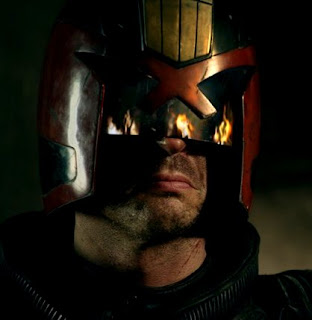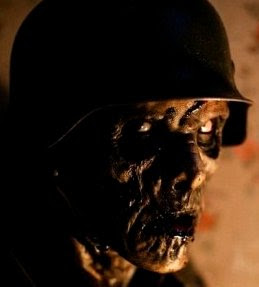DREDD (2012)
Carl Urban as Judge Dredd. A fusion of Dirty Harry and Desperate Dan, the super fascist was named the seventh greatest comic book character by Empire in 2011, beaten only by Superman, Batman, John Constantine, Wolverine, Spider-Man and The Sandman.
THE British comics scene of the mid to late seventies mirrored the changing social and political environment. Publications such as Warlord had started a more grittier trend away from the Beano/Dandy norm, and within the rise of radical trade unionism and an increasing punk ethic, the antihero became a leading light. This shift was typified by Action comic: 'Hellman of Hammer Force', the story of a German Panzer major, and the JAWS cash-in 'Hook Jaw', established a pattern for unconventional or unsympathetic characters, while 'Look Out for Lefty' was a football strip which openly depicted hooliganism on the terraces. Within weeks of the first issue the media had picked up on the title's violent content, with The Sun dubbing Action "the seven penny nightmare." Following its withdrawal Action's co-founder Pat Mills unleashed the science-fiction themed 2000AD in 1977, essentially Action in space. Early strips were particularly honed to the forerunner's expertise, with 'Flesh' a bloodthirsty time-travel story involving dinosaurs, and 'Shako' essentially 'Hook Jaw' with a polar bear.
Futuristic law enforcer Judge Dredd first appeared in the second "prog" of 2000AD. Britain's best-known strip character of the past thirty-five years was in fact created by Canadian-born writer John Wagner and Spanish artist Carlos Ezquerra; Dredd is the most notorious of a group of super cops, religiously disgusted yet righteously determined to fight crime in the post-apocalyptic milieu that is Mega-City One. An encapsulation of Eastern American cities with a population of four-hundred million crammed into Dickensian tower blocks, this megalopolis houses The Hall of Justice (at once judge, jury and executioners). Straddling an armour-plated patrol bike, living by his stock phrase "I am the Law," and always donning his visored-helmet, Dredd fights more and more outlandish adversaries within the Mega-City One walls and in the wastelands beyond, affectionately labelled The Cursed Earth. His most grotesque foe - Judge Death - is a skeletal inter-dimensional tyrant who considers life itself a crime.
The cover that got Action banned. An unfortunate colouring decision - making a police helmet the same shade as a fallen member of the public - was the final straw.
The Judge Dredd strip was originally informed by the cinematic landscape of the 1970s - vigilantes, out-of-control cops, dystopian futures - and Wagner even suggested to Ezquerra that he used David Carradine's character from DEATH RACE 200 for his main visualisation of Dredd. This British/South African co-production - directed by Pete Travis and written by Alex Garland - at last brings a faithful version of the character to the screen, following Sylvester Stallone's version of 1995. With DREDD, it is refreshing to see a comic book movie that strikes at the core of an iconic character without overt allegory, bloated posturing or need of an origin story. Here its just another day at the office as Dredd (Karl Urban), partnered by psychic rookie Anderson (Olivia Thirlby), investigate a triple homicide at the 200-storey Peach Trees block. The Judges discover that a criminal gang - led by Ma-Ma (Lena Headey) - have taken over the building and are using it as a base to market the designer Slo-Mo drug.
Either viewed in 3D or 2D, DREDD is a robust, action-based entertainment given a distinctive visual motif with its slow-motion sequences: everything from bath water to blood spray are given a hallucinogenic twist, with Slo-Mo a much-needed excursion to slow chaos down around the user and the viewer. There is never any great hope in Garland's fantasy screenplays - 28 DAYS LATER... saw most of Britain wiped out by the infected, and SUNSHINE revolves around a suicide mission to the stars - but here the writer manages to evoke a tangible futurism: the inward-looking sets are impressive, and offset only by fleeting exterior CGI of Johannesburg. Consequently it is a rounded illustration of the comic strip world, and in a pretty thankless role, Urban's square jaw is fine. It is, however, Thirlby that excels in such a daunting baptism of fire.





